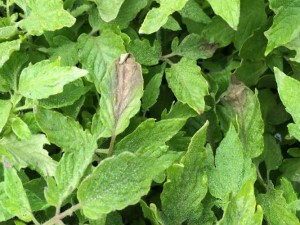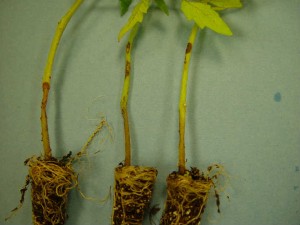What Is It? | Facts in Depth| For the Professional Diagnostician
Tomato Diseases | Botrytis Gray Mold
Botrytis Gray Mold
Identification
Leaves
Young infected leaves first appear as brown with blighted areas, often V-shaped, that progress up the petiole and into the stem.


Images of Botrytis gray mold symptoms on tomato leaves (left) and lettuce leaves (right).
Stems
Gray-brown velvety mold spots, or mycelia, grow on the leaves or stems. Infections on the stem can lead to girdling and wilting. The stems then turn white and develop cankers. This leads to an overall decline in plant health.


Symptoms on the stems of tomato seedlings (left) and plants (right).
Flowers
As the disease progresses on older plants, the flowers may become infected and turn brown and die. Gray conidiophores producing conidia (spores) will cover the dying flowers and the calyx of the fruit. Infections spread from flowers to the fruit and back toward the stem. On aging flowers and fruits, a gray, fuzzy mycelium coats the surfaces.
Fruits
Fruits may develop ghost spots, where the spores of the fungus germinate and penetrate the fruit surface, but infection terminates. Subsequently, a necrotic fleck surrounded by a whitish halo or circular rings are left. Fruits also decay and turn light brown or gray and begin to rot. Gray mold may be visible on the fruit calyx.



Pathogen Biology
Botrytis cinerea overwinters as sclerotia or mycelia in soil and plant debris for several months to years. Under favorable conditions, the sclerotia can germinate; initial mycelial growth is white in color, but quickly darkens to a gray color. The pathogen searches for nutrients being leaked through wounds on the plant. Once a wound is found, B. cinerea invades the plant and rapidly colonizes healthy tissues including the stem, leaf, petiole, peduncle, and fruit. Once the pathogen infects the stem it often leads to stem canker, which is the most destructive stage of the disease. Conidia (spores) form from specialized structures on the mycelium called conidiophores and are easily spread by wind, over-head irrigation or water sprays, tools, machinery, and workers. Spores germinate and penetrate wet/moist plant surfaces within 5 to 8 hours when the temperature is optimal, between 60 – 70°F. A new infection can produce visible masses of spores and will continue in multiple cycles throughout the season.
Favorable Environmental Conditions
Favorable conditions are cool and wet (high humidity >80%) with moderate temperatures of 65 – 75°F. Optimum spore germination temperatures are between 60°F and 70°F.
Often Confused With
- Sclerotinia white mold – Infected stems become bleached and are covered with a very fuzzy white mycelium. This mycelium can spread to flowers and other parts of the plant, similar to Botrytis gray mold.
- Rhizopus rot – Mycelial growth is black and very fuzzy, resembling that produced by Botrytis cinerea. Severe infection on the fruit becomes rotted, but unlike Botrytis gray mold, the fruit also becomes tough, dried, and mummified.
Scouting Notes
Periodically and closely monitor for disease symptoms and signs of Botrytis (fuzzy gray mold growth) in wounded tissues (e.g., broken stems, damaged leaves by mechanical injury or spray damage) and fading flowers, especially in the spring and fall.
Thresholds
Currently, there is no threshold information for Botrytis gray mold.
Management Notes
- Follow Sound Cultural Practices – Sanitation of tools will aid in preventing further infections of Botrytis gray mold. If symptomatic plants or plant parts are found, remove and setroy all infected tissue. Collect and discard any faded flower blossoms and fallen petals to prevent germination of any overwintering structures from the pathogen. Maintain Healthy Plants – Chemical control via fungicides is rarely needed and plant health can be maintained through proper fertilization, irrigation, and pruning practices. Maintaining soil moisture and nutrients will keep the plant healthy and less susceptible to Botrytis gray mold infections.
- Increase Air Circulation – Maintain adequate temperatures and ventilation by reducing overcrowding of plants. This can be achieved by using wide spacing to promote drying and increasing air circulation. Also, avoid excess water on the surfaces of plants or puddling on the high tunnel floors by not using overhead irrigation systems. This is especially important during times of high humidity. Prune tomatoes judiciously to promote air circulation. Clean and sanitize hands and pruning tools regularly.
- Avoid Damaging Plants – As stated in the pathogen biology section, the pathogen Botrytis cinerea best colonizes healthy plant tissues when a wound is present. Wounds leak nutrients that the pathogen can utilize. Once the pathogen enters healthy tissues, it colonizes very rapidly leading to further spread of the disease. Use good pruning techniques to avoid damaging the plants.
